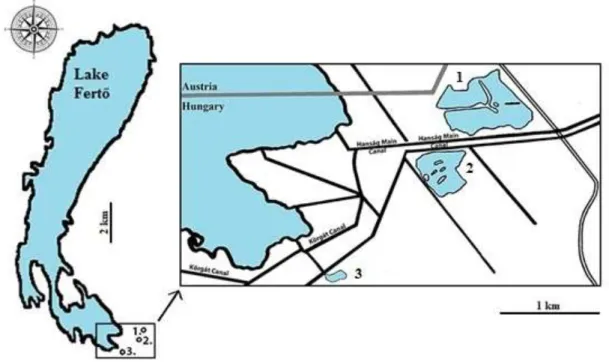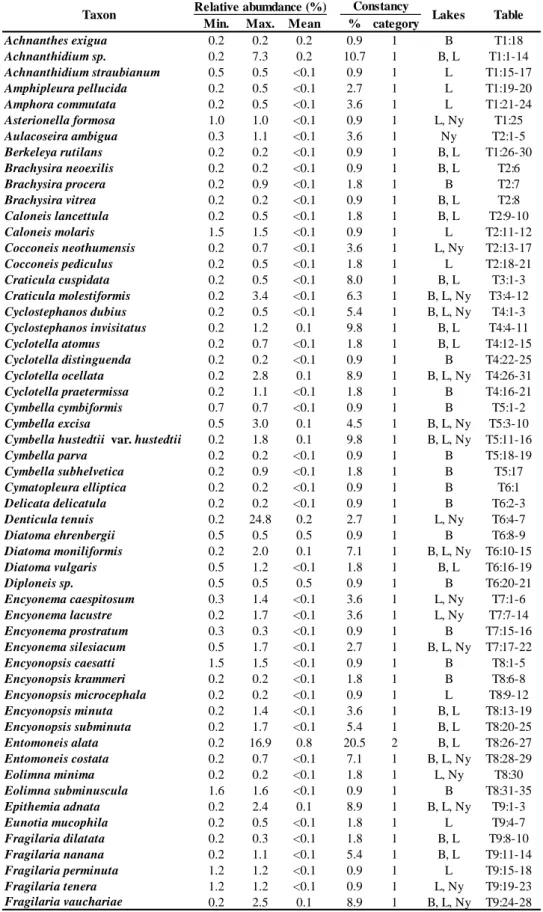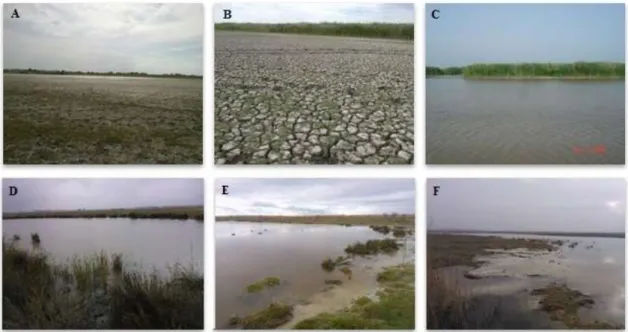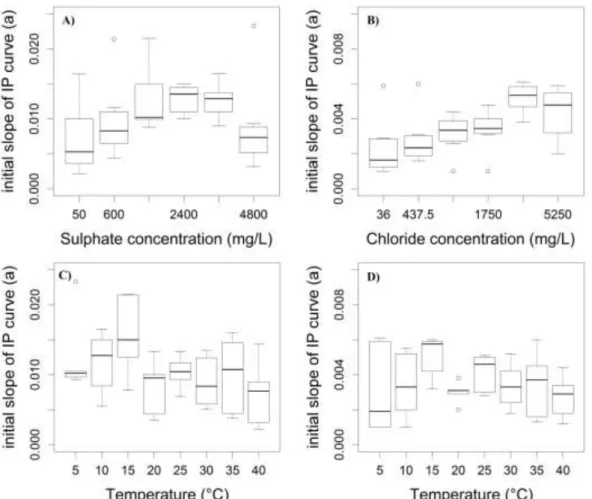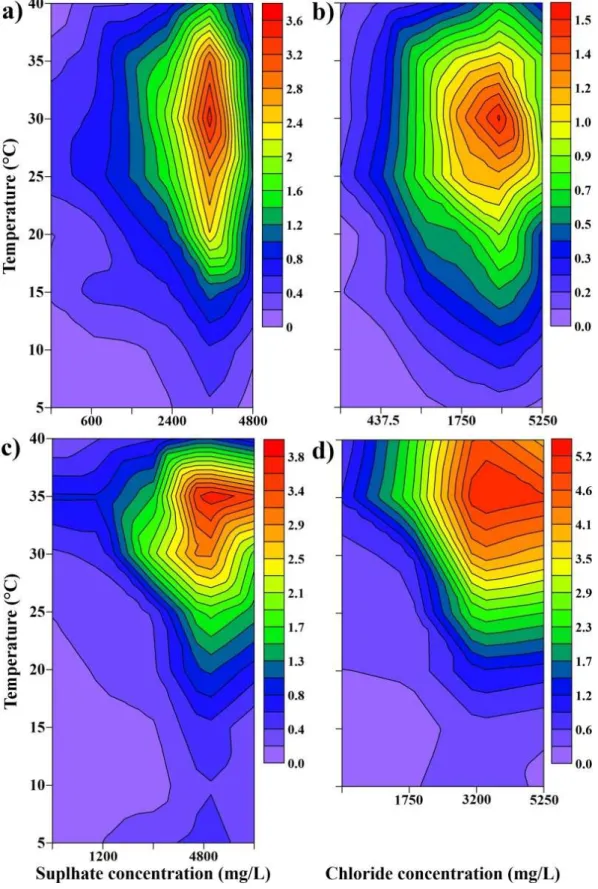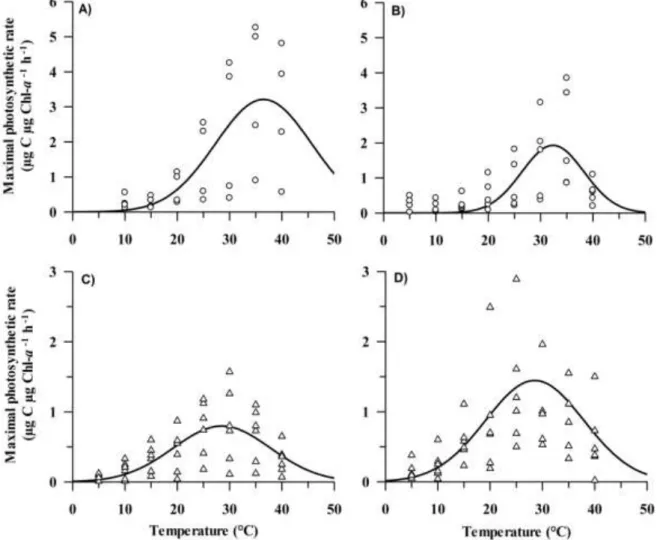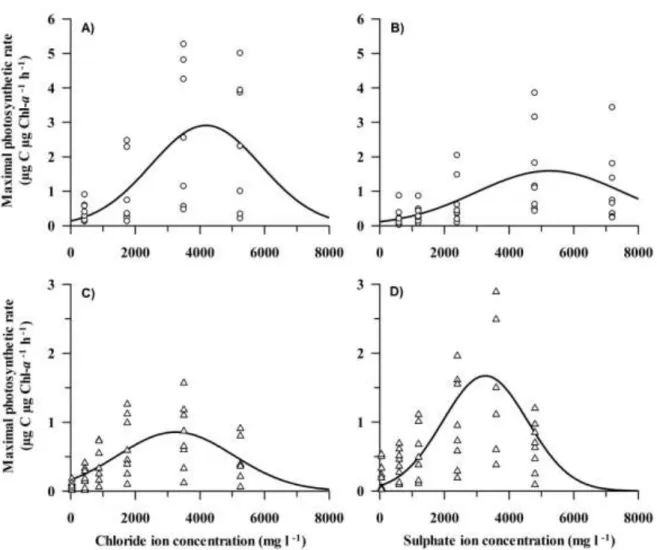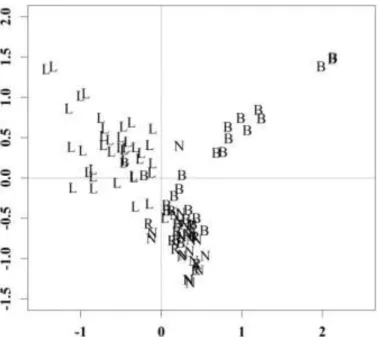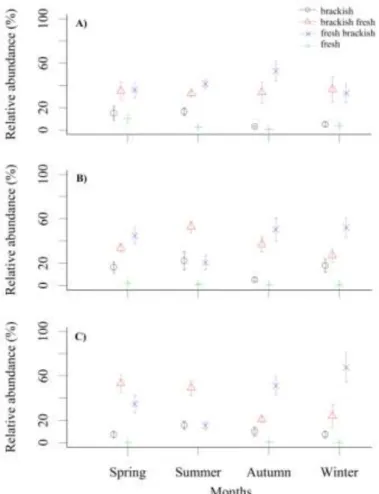University of Pannonia
Doctoral School of Chemistry and Environmental Sciences
and
Department of Limnology
Stress and disturbance in benthic diatom assemblages
Examples from lakes and streams and from the field and laboratory studies
Supervisors
Dr. Csilla Stenger-Kovács PhD, associate professor, University of Pannonia, Department of Limnology
Prof. Dr. Judit Padisák DSc, institute director professor, University of Pannonia, Department of Limnology; research group leader, MTA-PE, Limnoecology Research Group, Hungarian Academy of Sciences
Ph.D. Dissertation Edina Lengyel
2016
Photo by Edina Lengyel
2
Stress and disturbance in benthic diatom assemblages
Készült a Pannon Egyetem Kémiai és Környezettudományi Doktori Iskolája keretében
Témavezető: Dr. Stenger-Kovács Csilla
Elfogadásra javaslom (igen / nem) ...
(aláírás) Témavezető: Prof. Dr. Padisák Judit
Elfogadásra javaslom (igen / nem) ...
(aláírás) A jelölt a doktori szigorlaton ...%-ot ért el,
Az értekezést bírálóként elfogadásra javaslom:
Bíráló neve: ………. igen / nem
...
(aláírás) Bíráló neve: ………. igen / nem
...
(aláírás) A jelölt az értekezés nyilvános vitáján ...%-ot ért el.
Veszprém, ……….... ...
a Bíráló Bizottság elnöke A doktori (PhD) oklevél minősítése...
...
Az EDHT elnöke
3
Abbreviations
DO Dissolved oxygen
DO% Dissolved oxygen saturation
TP Total phosphorus
COD Chemical oxygen demand
SRSi Soluble reactive silica
SRP Soluble reactive phosphorus
Pmax Maximal carbon uptake
Ik Photoadaptation parameter
Ps Biomass specific photosynthetic activity
R Growth rate
α Initial slope of the P-I curve
β Photoinhibition parameter
IDH Intermediate disturbance hypothesis
PAR Photosynthetically active radiation
DIC Dissolved inorganic carbon
DOC Dissolved organic carbon
TN Total nitrogen
4
Contributions to the research
The sampling of saline lakes was carried out with some assistance, such as Dr. Csilla Stenger-Kovács, Dávid Németh, István Kacsala and Beáta Szabó. On the field, Attila Pellinger, Dr. András Ambrus, Péter Kugler and Gábor Takács, as the colleagues of Fertő- Hanság National Park helped us during the whole study period. The samplings in Torna- streams were also teamwork with the assistance of many students and colleagues, such as Csaba Kálmán, Dr. Csilla Stenger-Kovács, Dr. Kata Karádi-Kovács and Dr. Tamás Kucserka.
The preparations of the samples collected from saline lakes were carried out by Dávid Németh in 2014. Additionally, the accurate identifications of some diatom species were required electron microscopic analysis which was carried out by Dr. Csilla Stenger- Kovács and Dr. Krisztina Buczkó’s helps.
The chemical laboratory analyses of all the samples were teamwork with the assistance of many students, colleagues and technicians, such as István Kacsala, Dávid Németh, Dr. Csilla Stenger-Kovács, Dr. Viktória Üveges, Katalin Eszter Hubai, Dr. Kata Karádi-Kovács, Csaba Kálmán, Dr. Tamás Kucserka, Tamás Pálmai, Beáta Szabó, Tamás Hammer, Géza Balázs Selmeczy, BSc and MSc students.
For Nitzschia aurariae, the processes of photosynthetic activity and the other necessary laboratory works were carried out mainly by Diána Lázár.
The calculation of AVTD values was carried out by Dr. Éva Hajnal.
5
Content
ABBREVIATIONS ... 3
CONTRIBUTIONS TO THE RESEARCH ... 4
KIVONAT ... 8
ABSTRACT ... 10
RESUMÉ ... 12
1.GENERAL INTRODUCTION ... 14
1.1.DEFINITION AND SYNONYMS OF PHYTOBENTHOS ... 14
1.2.TAXONOMIC COMPOSITION AND DIVERSITY OF PHYTOBENTHOS ... 14
1.3.APPLICATION OF DIATOMS ... 15
1.4.PRIMARY ENVIRONMENTAL FACTORS IN LENTIC AND LOTIC ENVIRONMENTS ... 16
1.4.1. Light ... 16
1.4.2. Nutrients ... 17
1.4.3. Temperature ... 18
1.4.4. Salinity ... 19
1.4.5. Substrate ... 20
1.4.6. pH ... 21
1.4.7. Grazing ... 21
1.5.STRESS AND DISTURBANCE ... 22
2.DIATOM FLORA UNDER STRESS CONDITIONS ... 27
2.1.INTRODUCTION ... 27
2.2.AIMS ... 28
2.3.MATERIAL AND METHODS ... 28
2.3.1. Study areas ... 28
2.3.2. Sampling process and diatom analyses ... 29
2.4.RESULTS ... 30
2.4.1. Legény-tó ... 31
2.4.2. Borsodi-dűlő ... 32
2.4.3. Nyéki-szállás ... 33
2.5.DISCUSSION ... 36
3.STRESS TOLERANCE ALONG LIGHT-, TEMPERATURE-, SULFATE- AND CHLORIDE GRADIENTS ... 39
3.1.INTRODUCTION ... 39
3.2.AIMS ... 40
3.3.MATERIAL AND METHODS ... 41
3.3.1. Study areas ... 41
3.3.2. Isolation and culturing ... 41
6
3.3.3. Laboratory experiments ... 42
3.3.4. Statistical analyses ... 44
3.4.RESULTS ... 45
3.4.1. P-I characteristics ... 45
3.4.2. Pmax-temperature-conductivity linkage ... 48
3.5.DISCUSSION ... 49
3.5.1. Ion preference ... 50
3.5.2. The optimal ion concentrations and conductivity... 51
3.5.3. Light preference ... 51
3.5.4. Temperature preference ... 53
4.STRESS AND DISTURBANCES IN SODA PANS ... 55
4.1.INTRODUCTION ... 55
4.2.AIMS ... 57
4.3.MATERIAL AND METHODS ... 57
4.3.1. Study areas ... 57
4.3.2. Sampling process and diatom analyses ... 58
4.3.3. Chemical and physical analyses ... 58
4.3.4. Statistical analyses ... 58
4.4.RESULTS ... 59
4.5.DISCUSSION ... 65
4.5.1. Main drivers in diatom composition of the reconstructed pans ... 65
4.5.2. The response of diatoms to the typology and the water management of the pans ... 65
5.EQUILIBRIUM STATES OF BENTHIC DIATOMS IN A LOTIC ECOSYSTEM ... 70
5.1.INTRODUCTION ... 70
5.2.AIMS ... 71
5.3.MATERIAL AND METHODS ... 72
5.3.1. Study areas ... 72
5.3.2. Sampling process and diatom analyses ... 72
5.3.3. Chemical and physical analyses ... 73
5.4.RESULTS ... 74
5.4.1. Fulfillment of the first and second condition of equilibrium state ... 74
5.4.2. Third condition of equilibrium state ... 75
5.4.3. Chemical and physical parameters ... 76
5.5.DISCUSSION ... 77
6.ACKNOWLEDGEMENTS ... 82
7.REFERENCES ... 83
7
8.THE MOST SIGNIFICANT RESULT IN THESIS POINTS ... 112
9.LIST OF PUBLICATIONS... 118
9.1.CUMULATIVE ... 118
9.2.PAPERS DIRECTLY RELATED TO THE DISSERTATION ... 118
9.3.OTHER PAPERS ... 119
9.4.CONGRESS ATTENDANCES DIRECTLY RELATED TO THE DISSERTATION ... 120
APPENDIX ... 123
8
Kivonat
A stressz és a bolygatás fogalmát a mai napig gyakran összekeverik, mivel elkülönítésük nehéz köszönhetően annak, hogy a környezeti faktorok nem sorolhatók be egyszerűen az egyes csoportokba. Pedig a megkülönböztetésük fontos lenne a helyes tudományos következtetések levonása miatt. A jelen kutatás alapvető célja a stressz és bolygatás hatásának vizsgálata bentikus kovaalga közösségekben mind terepi, mind kísérletes körülmények között, specifikusan:
(i) feltárni három kis szikes tó bentikus kovaalga flóráját, amelyeknek többszörös stresszt kell elviselniük;
(ii) meghatározni két kovaalga faj optimumát és toleranciáját fény, hőmérséklet és vezetőképesség gradiens mentén;
(iii) megvizsgálni a stressz és bolygatás komplex hatását három szikes tóban referencia helyek bevonásával; valamint
(iv) meghatározni a lehetséges egyensúlyi állapotok kialakulását folyóvízi környezetben.
Ennek érdekében két éves terepi gyűjtésekből származó adatsort (bevonat, fizikai és kémiai paraméterek) használtam fel, valamint tisztatenyészetet hoztam létre az ökofiziológiai kísérletekhez. Az alábbi fő megállapításokra jutottam:
(i) Az eredmények a tudomány számára új információt nyújtanak a Fertő-Hanság három szikes tavának bentikus kovaalga flórájáról, melyet fotókkal részletesen dokumentáltam. A tavakban a kovaalga közösség térbeli eloszlására nincs hatással a szubsztrát típusa köszönhetően a többszörös stressznek. Tekintve az egyes konstanciával jellemezhető fajok magas számát, az alacsony fajszámot, a lehetséges új fajokat és a számos Vörös listás fajt, a vizsgált tavak bentikus kovaalga flórája egyedi és jelentős természetvédelmi értékkel rendelkezik.
(ii) Mindét faj, a Nitzschia frustulum és N. aurariae is magas vezetőképesség optimummal és széles sótartalom toleranciával jellemezhető, ami ökológiai előnyt jelenthet számukra más fajokkal szemben. Habár a két faj niche-e átfed egymással, a N. aurariae kedvezőbb helyzetben van, mivel magasabb szalinitás stresszt képes elviselni. A fajok ionpreferenciája és alacsony-közepes fényigénye lehet a magyarázat az elterjedésükre és dominanciájukra. Habár a fajok magas hőmérsékleti optimummal és széles toleranciával rendelkeznek, a fotoszintetikus aktivitásuknak a csökkenése várható a klímamodellek által
9 jelzett növekvő, egyes esetekben extrém értékeket elérő hőmérsékletnek köszönhetően.
(iii) A kezdeti, ígéretes eredmények után, a Borsodi-dűlő és Nyéki-szállás jelenlegi ökológiai állapota mérsékeltté romlott: a természetes fizikai, kémiai és biológiai jellemzőik még mindig nem megfelelőek köszönhetően az erősen szabályozott vízszintjüknek és a Fertő felöl alkalomszerűen érkező vízutánpótlásnak. Ezzel szemben a Legény-tó állapota messze elmarad a természetestől köszönhetően a természetes hidrológiai háttér hiányának. Az említett bolygatások olyan váratlan változásokat okoznak a közösség szukcessziójában ún. “shiftek” és
“reverziók” formájában, amelyek megakadályozzák a szikes tavakra jellemző természetes közösség vagy egy lehetséges alternatív stabil állapot kialakulását.
A vizsgált tavak florisztikai szempontból hot-spotoknak számítanak, ezért szükséges lenne a jó ökológiai állapotuknak a megőrzése, mely elérhető a természetes hidrológiai és diszturbancia rendszerük helyreállításával.
(iv) A vizsgált folyóvízi ökoszisztémában kapott konklúziók hasonlóak, mint amit a mérsékelt övi tavaknál tapasztaltak: az egyensúlyi állapotok ritkák (csupán három időszakra szűkíthetők: 2008 júliusa, 2009 májusa, és 2010 januárja), megjósolhatatlanok, ideig-óráig tartóak és leginkább egy faj monodominanciájával jellemezhetők (Cocconeis placentula sensu lato és Navicula lanceolata). A kialakult egyensúlyi állapot rugalmassága biztosíthatja a biotikus állandóságot a környezeti háttérparaméterek nagymértékű fluktuálásának ellenére is. Néhány paraméternél olyan küszöbértékek állapíthatók meg, melyek önmagukban elegendő mértékűek a steady-state állapot kialakulásának megelőzésére. Mindazonáltal viszonylagosan stabil környezetben is kialakulhat egyensúlyi állapot, amelyhez a fitoplanktonnál tapasztaltakhoz képest hosszabb időre van szükség.
10
Abstract
The term of stress is often confused with the definition of disturbance, probably because none of the environmental variables can be clearly claimed as stressor or disturbance. The clarification and the differentiation of these factors are very important, because their impacts need different approaches. The basic aim of present dissertation is to study the effects of stress and disturbance in benthic diatom communities in the field and laboratory studies, specifically:
(i) to identify what kind of diatom species can tolerate multiple stress in three alkaline, saline, shallow soda pans;
(ii) to recognize the optimum and tolerance of two diatom species along light, temperature and conductivity gradients;
(iii) to investigate the complexity of three impacts (natural, and human disturbances, stress) in three saline pans using reference sites; and
(iv) to determine the potential establishment of equilibrium state of benthic diatom assemblages in a stream ecosystem.
For these purposes, two-year datasets (phytobenthos, physical and chemical parameters) were applied from the field and cultures were grown for laboratory ecophysiological experiments. The major conclusions are the following:
(i) New information is provided with detailed photo-documentation about the diatom flora of three pans in the Fertő-Hanság region. In these ecosystems, the spatial distribution of diatoms is not affected by the substrates due to the multiple stresses. Regarding the high number of constancy-one species, the low species richness, the possible new species and many Red-list species, the benthic diatom flora of the studied pans are unique and have significant conservation value.
(ii) Both Nitzschia frustulum and N. aurariae have high salinity optimum with broad tolerance, which represents an ecological advantage against other species.
However, the niche of the species is overlapped: N. aurariae have higher ecological advantages tolerating high level stress. The ion preference and the low-medium irradiance demand of the species may explain their distribution and dominance. The species have high temperature optima and broad tolerance, but their photosynthetic activity will decrease under increasing, sometimes extreme temperatures, as predicted by the climate change models.
11 (iii) After the initial, promising results, the current ecological status of Borsodi-dűlő and Nyéki-szállás fall into the moderate category: their natural physical, chemical and biological features are still unsatisfactory due to the strongly manipulated water level and the occasional water supply originating from Lake Fertő. Regarding the Legény-tó, this pan was far from the natural conditions due to the lack of the natural hydrological regime. The disturbance events cause unpredictable and repeated shifts or reversions in the natural succession of the community preventing the developments of characteristic communities for soda pans or the possible alternative stable states. These pans are diversity hot-spots, so their good ecological status should be completely reached by restoring their natural hydrological and disturbance regimes.
(iv) The conclusions in the studied lotic ecosystem are similar to those found in temperate lakes: equilibrium states are rare (can be restricted to three separate months: July 2008, May 2009 and January 2010), unpredictable, ephemeral, and are mostly characterized by monodominance (Cocconeis placentula sensu lato and Navicula lanceolata). The resilience of a developed equilibrium phase may ensure biotic constancy even though the underpinning environmental background fluctuates at higher amplitude. Regarding some parameters, threshold values could be defined, where the degree of change alone was enough to prevent the development of an equilibrium phase. But the equilibrium state may occur in relatively-stable environments, too. Contrary to the phytoplankton, their establishment requires a longer time to develop corresponding to difference in generation times.
12
Resumé
Les concepts du stress et de la perturbation sont souvent confondus, en raison de la difficulté à classer les facteurs environnementaux dans l’un ou l’autre de ces concepts.
Pourtant, leur distinction permettrait l’émission de conclusions plus fiables. L'objectif principal de cette étude est d’examiner les effets du stress et de la perturbation dans les communautés de diatomées benthiques par l’intermédiaire d’études expérimentales et de terrain.
Pour cela, il convient:
(i) d’identifier les flores de diatomées benthiques tolérant les stress multiples, dans 3 lacs salins;
(ii) de déterminer les conditions optimales et de tolérance de deux espèces diatomées selon un gradient de lumière, de température et de conductivité;
(iii) d’examiner la complexité de trois effets (perturbations naturelles, humaines et stress) dans trois bassin salins, en utilisant des sites de référence;
(iv) de définir la formation possible de l'état d'équilibre des communautés diatomées benthiques dans l’écosystème aquatique.
Dans ce but, les données collectées durant deux années de terrain (revêtement, paramètres physiques et chimiques) ont été utilisées, associées à la mise en place de cultures pures pour les expériences écophysiologiques.
Les principales conclusions sont les suivantes:
(i) La génération de nouvelles données sur la flore de diatomées benthiques des trois bassins salins de la région de Fertő-Hanság, agrémentés de nombreuses photographies. Dans cet écosystème, la distribution spatiale des communautés de diatomées ne semblent pas influencées par le type de substrat induit par le stress multiple. En raison du grand nombre d'espèces caractérisées avec le constance 1, la faible richesse spécifique, le potentiel de nouvelles espèces et les nombreuses espèces classées en liste rouge, la flore unique de diatomées benthiques des bassins salins montre une valeur de conservation importante.
(ii) Toutes les espèces (Nitzschia frustulum et N. aurariae aussi) ont un haut optimum et une large tolérance à la conductivité, leur conférant un avantage écologique remarquable face aux autres espèces. Bien que les niches écologiques des deux espèces se recouvrent, N. aurariae est favorisée par rapport N. frustulum en raison de sa tolérance face au stress de salinité. La
13 préférence ionique des espèces et leur besoin de lumière faibles à modérés peuvent expliquer leur distribution et dominance. Malgré l’optimum haut et la large tolérance des espèces face à la température, la diminution de l'activité photosynthétique peut être expliquée par l’atteinte possible de valeurs extrêmes, comme le suggèrent les modèles climatiques.
(iii) Après des premiers résultats prometteurs, les états écologiques actuels de Borsodi-dűlő et Nyéki-szállás sont devenus plutôt modérés : les caractéristiques naturelles biologiques, physiques et chimiques ne sont pas satisfaisantes en raison d’étiages fortement régulés et le prélèvement d’eau occasionnel provenant du lac Fertő (Neusiedlersee). L'état écologique de Legény-tó est loin des conditions naturelles en raison du manque de système hydrologique naturel.
Ces perturbations entrainent des changements imprévisibles et récurrents dans la succession naturelle des communautés, et empêchent la mise en place de communautés caractéristiques de milieux salins ou la mise en place d’un possible état d’équilibre. Ces bassins sont de véritables hotspots de diversité ce qui suggère la possible atteinte d’un bon état écologique par la restauration des régimes hydrologiques naturels, soumis aux perturbations.
(iv) Les conclusions obtenues dans cet écosystème lotique sont similaires à celles obtenues dans les lacs tempérés : les conditions d'équilibre sont rares (réduites à trois périodes: juillet 2008, mai 2009 et janvier 2010), imprévisibles, éphémères et caractérisées par la dominance d'une espèce (Cocconeis placentula sensu lato et Navicula lanceolata). La résilience de l'état d'équilibre peut donc assurer la stabilité biotique malgré l’importante fluctuation des paramètres environnementaux. Concernant certains paramètres, des valeurs limites peuvent être définies, se suffisant à elles-mêmes pour empêcher la formation d’un état d’équilibre. Cependant, l’état d'équilibre peut également s’observer dans des environnements relativement stables. Contrairement au phytoplancton, son installation requiert plus de temps en raison de temps de génération différents.
14
1. General introduction
1.1. Definition and synonyms of phytobenthos
According to Wetzel (1979), the term of “Aufwuchs” includes organisms, which are attached to or move upon any submerged substratum without penetrating into it. In contrast, the benthos including fungal, bacterial, protozoan and other attached animal components is closely related to the substratum. Periphyton, as one of the subcategory of the benthos involves fungi, bacteria or microscopic algae which are growing on plant or any kind of substrate, phytobenthos refers to only the algal communities (Wetzel, 1983).
Often, the unattached organisms are associated with the periphyton assemblages, which leads to further classification: euperiphyton (immobile organisms attached to the substrates), pseudoperiphyton or metaphyton (free-living, motile organisms creeping among or within the periphyton; Wetzel, 1979). In some cases the term biofilm is also used as a synonym of periphyton, but it is rather preferred in other scientific fields and refers largely to bacteria and protozoa (O'Toole et al., 2000). As it was concluded earlier by several researchers, the type of substrate is an important factor, and based on the available habitats, several further terms are used in freshwater lentic ecosystem (Goldsborough and Robinson, 1996; Azim et al., 2005): epilithon (on rocks or other inorganic matter), epipelon (on fine sediment), epiphyton (on macrophytes), episammon (on sand), epizoon (on aquatic animals).
1.2. Taxonomic composition and diversity of phytobenthos
On any submerged substrate, colonization processes immediately start and periphyton layer develops within a short period (Azim et al., 2005). As the first step of primary succession, the deposition of a coating of organic substance is assumed. Within hours, bacteria attach to the substrates by mucilaginous strands ensuring suitable binding site for other components, as colloidal, organic and inorganic elements (Flemming, 1995). After a few days, the colonization of small pennate diatoms (e.g. Navicula) and other single celled or coenobial species (e.g. Scenedesmus) start and is followed by short- and long-stalked species and diatoms with rosettes and mucilage pads (e.g. Achnanthidium, Cymbella, Ulothrix, Oscillatoria) (Stevenson, 1996; Azim et al., 2005).
These benthic algal growth forms can mean competitive advantages for the species in the different environments. Adnate algae can avoid the shear stress of severe currents, be resistant to grazing, but become nutrient and light limited (McCormick and Stevenson,
15 1989; Stevenson, 1996; Passy, 2007). Apically attached algae have competitive advantage in slow current environment and can overgrow the adnate forms. Stalked and filamentous forms can access to the light and nutrient sources, but they are threatened by the sudden disturbances such as shear forces and grazing (Stevenson, 1996; Passy, 2007). Motile species have the ability to change their position within the benthos, but they are sensitive to the flood velocity due to the lack of any stabilizing aid (Passy, 2007).
In freshwater ecosystems, most benthic algae are Cyanophyta, Chlorophyta, Bacillariophyta and Rhodophyta (Stevenson, 1996). In shallow lentic environments, the phytobenthos is dominated by Achnanthidium, Amphora, Diatoma, Fragilaria, Navicula and Nitzschia (Bacillariophyceae). Lyngbya and Oscillatoria species from Cyanophyta, Spirogyra and Mougeotia species from Chlorophyceae are also dominant taxa in wetland ecosystems (Goldsborough and Robinson, 1996; Azim et al., 2005). Usually, the phytobenthos of streams consist of diatoms, cyanophytas, chlorophytes, rhodophytes and xantophytes. Achnanthidium, Cocconeis, Cymbella, Diatoma, Fragilaria, Gomphonema, Meridion, Navicula, Planothidium, Rhoicosphenia and Ulnaria genus make up the phytobenthos as the components of Bacillariophyceae. Phormidium, Oscillatoria, Calothrix species from Cyanophyta, Closterium, Oedogonium, Scenedesmus, Spirogyra, Stigeoclonium, Ulothrix species as the members of Chlorophyceae may also dominate in lotic ecosystems (Azim et al., 2005).
The taxonomical diversity, the abundance of the species and the time to reach the phytobenthos’ maximal biomass peak depend on several abiotic and biotic factors, such as the available nutrient content and light intensity. Development of the biomass can peak lasts for a few days to months, but according to the generally accepted concept, mature phytobenthos layer can occur within 4 weeks after the start of the colonization (Azim et al., 2005).
1.3. Application of diatoms
Diatom assemblages themselves are typically used instead of the entire phytobenthos for assessing the ecological status of the ecosystems (Stevenson and Pan, 1999). Stevenson and Pan (1999) summarized the three most important features of the diatoms, which qualify them to be the ideal indicators for determining ecological conditions. These are:
(i) their importance in ecosystems: the most widespread and diverse group; roles in the food webs, water oxygenation and biogeochemical cycle;
16 (ii) their utility as indicators: direct, fast and sensitive response to the changing
environmental conditions and
(iii) their easy examination: cleaning, preparation, preservation, exchange and reanalysis are easy; a number of publication are available for their identification.
In view of the above, the role and the usefulness of diatoms are unquestionable.
According to Vannote et al. (1980) the dominance of phytoplankton is expected in larger lotic and deeper lentic ecosystems against to the periphyton that is more abundant in shallow systems. These two groups are affected by different environmental factors and the opinions of the scientists who work in this field are divided. One group of the scientists recommends working with the planktonic diatoms (e.g. Reavie et al., 2010; Kireta et al., 2012), and the other group prefers benthic forms (e.g. Hill et al., 2000; Lane and Brown, 2007; Kireta et al., 2012). Applying the benthic form of diatoms, further problem presents itself: the exclusion or inclusion of the embedded planktonic and entrained benthic species.
Similarly to the Potapova and Charles (2007), present dissertation applied the use of the phytobenthos including the entrained species too.
1.4. Primary environmental factors in lentic and lotic environments
The phytobenthos are affected by several abiotic factors, such as light intensity, temperature, nutrients, hydrodynamics and substrate specificity. Additionally, the herbivory is dominant biotic factor (Hodgkiss and Law, 1985; Goldsborough and Robinson, 1996; Azim et al., 2005).
1.4.1. Light
As consisted of photolithoautotrophic organisms, the phytobenthos requires sufficient available light to develop. The available light is related to both physiology (photosynthesis) and ecology (competitive interactions) of the algae (Azim et al., 2005).
There is a widely accepted model to describe the relationship between photosynthetic activity and light intensity, which is called as P-I curve (photosynthesis- irradiance, Webb et al., 1974; Platt et al., 1981; Hill, 1996). According to this model, three phases of the ecophysiological process are distinguished:
(i) light-limited phase: positive linear relationship between the photosynthesis and irradiance; α (initial slope of the P-I curve) is its typical parameter;
(ii) light-saturated phase: the photosynthetic activity reaches its maximum (Pmax) at given irradiance (Ik);
17 (iii) photoinhibated phase: after the maximal photosynthetic activity, the photosynthesis can decrease (β>0) or it can more or less constant (β=0) with further increases in irradiance (Hill, 1996).
The photosynthesis mainly depends directly on the pH/available inorganic carbon source, irradiance and temperature, and indirectly on the nutrient content (Kirk, 1994).
The light quality (as spectral composition) and the light quantity (as intensity) are equally important (Azim et al., 2005). Only the PAR range of the global radiation is useful for the algae, which includes the light between 400 and 700 nm (Kirk, 1994). In lentic ecosystems, the vertical light extinction is critical regarding the the primary production as it determines the useful photosynthetic wavelengths and their intensity. The vertical light extinction in the littoral zone depends on the macrophyte and metaphyton density, turbulence, sediment resuspension and the water depth. In contrast, the light quality and quantity in streams mainly depend on the canopy of the ecosystem (Azim et al., 2005).
Every species has an optimal irradiance range for their growth. Thus, the available light intensity can affect the taxonomic composition of phytobenthos by selecting the species based on their different ecological demands. For example, many cyanobacteria and diatoms can tolerate low light availability (10-231 μmol m-2s-1) (Reynolds, 1988; Padisák, 2004; de Tezanos Pinto and Litchman, 2010) and can grow at 5-6 µmol m-2s-1 (Richardson et al., 1983; Langdon, 1988) making them good competitors for light. In contrast, most green algae can utilize higher irradiance intervals (85-510 μmol m-2s-1) (Pillsbury and Reynolds, 1988; Hill, 1996; Lowe, 1999; Padisák, 2004). The ecological light preferences of the species are in accordance with the seasonal succession patterns of the phytobenthos, since diatoms are the dominant members in spring when the global radiation is lower, green algae dominate in summer associated with higher light intensity (Azim et al., 2005).
Furthermore, the available light regime can determine the algal assemblages by selecting the different life forms. In general, non-motile, adnate species (such as Cocconeis) can tolerate strong light limitation, motile (such as Nitzschia) and epiphytic attached species (such as Epithemia) can avoid it by altering their position within the phytobenthos layer (Passy, 2007).
1.4.2. Nutrients
According to Epstein’s (1972) definition, the 17 life-essential elements can be sorted into two groups based on their concentrations: macro- and micronutrients (or trace elements).
Macronutrients, such as hydrogen, carbon, oxygen, nitrogen, potassium, calcium,
18 magnesium, phosphorous, sulphur, magnesium are required in higher concentrations (10-2 - 10-4 mol L-1). The most significant determinants are carbon, nitrogen and phosphorous, which might be available in limiting concentrations for the growth of algae. The optimal Redfield molar ratio for phytobenthos is 119C:17N:1P (Redfield et al., 1963). Silicate can also be essential for diatoms or silica-scaled chrysophytes (Hopkins and Hüner, 2004b), it is generally required in a ratio of 16Si:16N:1P (Brzezinski, 1985). Contrary to the macronutrients, trace elements are sufficient in low levels (<10-5 mol L-1) and include the chlorine, boron, iron, manganese, zinc, copper, nickel and molybdenum (Hopkins and Hüner, 2004b).
The nutrient accumulation and uptake are different in lotic and lentic environments (Stevenson, 1996; Azim et al., 2005). In lotic ecosystems, the increased nutrient loading is not necessarily associated with the higher nutrient uptake rate. It depends also on the flow rate, periphyton composition and condition. In lentic ecosystems, the nutrient uptake of benthic algae is related rather to the sediment-surface interactions, than the water column.
Thus, the nutrient uptake depends on the conditions of the lake bottom (e.g. oxygen supply, redox potential). Whenever wetlands or shallow lakes are in focus, the states of the sediment and water column are equally important.
Eutrophication is the most widespread form of water pollution causing changes in primary production, biochemical cycles and biological communities (Hall and Smol, 1999). The process of eutrophication is easy to follow by the changes in the composition of diatom communities. Diatoms are good competitors for P, cyanobacteria for N (Sommer, 1983; Tilman et al., 1986). Thus, the changes of N:P ratio involve the shift from diatoms to cyanobacteria in the assemblages (Tilman et al., 1986). Some diatom species, such as Amphora pediculus (Kützing) Grunow ex A.Schmidt, Aulacoseira granulate (Ehrenberg) Simonsen, Nitzschia palea, Rhoicosphenia abbreviata, Surirella brebissonii and Stephanodiscus hantzschii can be reliable indicators of eu- or hypertrophic waters, contrary to Cyclotella ocellata, Encyonopsis subminuta, which usually are abundant in oligotrophic conditions (Hall and Smol, 1992; Van Dam et al., 1994; Reavie et al., 1995).
1.4.3. Temperature
Temperature has major role in many biological processes (e.g. enzymatic processes, photosynthesis) (DeNicola, 1996). Not only the lower, but the higher temperature also can cause serious damage in these processes. For example, low temperatures may cause irreversible changes in membrane fluidity (Falkowski and Raven, 1997), and high
19 temperature results in higher dark reaction rate and respiration, reduced photosynthetic efficiency due to the denaturation of enzymes (Hopkins and Hüner, 2004b). However, often the effects of temperature and light cannot be separated from each other due to the strong collinearity observed in situ measurements (Azim et al., 2005).
Similarly to the light intensity, species have different temperature optima. For example Nitzschia species prefer higher temperature (~30 °C) (Barker, 1935), contrary to Navicula lanceolata which typically occurs in cold waters (Hofmann et al., 2011).
1.4.4. Salinity
The distributions of diatoms are highly correlated not only with the salinity, but also with the ionic composition (Servant-Vildary and Roux, 1990; Blinn, 1993; Cumming and Smol, 1993). Contrary the ionic composition, the effects of salinity are well-known. It can affect directly or indirectly the communities by affecting nutrients, controlling the cellular processes, causing osmotic and ionic stress, regulating the photosynthesis and the growth of the species (Hasegawa et al., 2000; Sullivan and Currin, 2000; Munns, 2002; Sudhir and Murthy, 2004).
Salinity originated from the product of the source waters hence a wide range of salinity is represented in aquatic ecosystems. There are some classifications to categorize the ecosystems based on their conductivity. According to Williams (1967), three categories were distinguished:
(i) freshwaters: salinity < 500 mg L-1 (<0.5 °/˳˳; ~ 670 µS cm-1)
(ii) subsaline waters: salinity 500 - 3000 mg L-1 (0.5 - 3 °/˳˳; 670-5500 µS cm-1) (iii) saline waters: salinity > 3000 mg L-1 (> 3 °/˳˳; ~ 5500 µS cm-1)
Based on Hammer’s (1986) classification, another three categories can be used:
(i) hyposaline waters: 3000 - 20000 g L-1 (3-20 °/˳˳; 5500-30000 µS cm-1) (i) mesosaline waters: 20000 - 50000 g L-1 (20-50 °/˳˳; 30000-70000 µS cm-1) (i) hypersaline waters: > 50000 g L-1 ( >50 °/˳˳; >70000 µS cm-1)
The strong correlation between the distribution of diatom species and salinity range is well documented (Blinn, 1993; Fritz et al., 1993). The freshwater species have distribution limits about the 3000 mg L-1 concentration of salinity. Based on paleolimnological datas (Fritz et al., 1999), Stephanodiscus minutulus, Fragilaria capucina var. mesolepta (Rabenhorst) Grunow are rare or missing above this threshold, contrary to Navicula fonticola which occur only under saline conditions. As a result of recent studies (Blinn, 1993; Veres et al., 1995; Żelazna-Wieczorek et al., 2015), Nitzschia commutata,
20 Hippodonta hungarica or Fragilaria vauchariae are associated with low salinity range, Anomoeoneis costata, Halamphora dominici have high salt tolerance, some species, such as Navicula veneta is “salt generalist” having broad tolerance. However, ecophysiological laboratory experiments could provide detailed and more accurate information about the optimum and tolerance of the species. Many of such investigations were carried out with the phytoplankton (mainly fast-growing easy to culture species) (e.g. Grant and Horner, 1976; Stramski et al., 2002; Roubeix and Lancelot, 2008), but those with benthic forms have been missing.
1.4.5. Substrate
The abundance of the algae is affected on a wide scale from climate- and landscape through the nutrient sources until the micro scale (Biggs, 1996; Stevenson, 1997). The type of substrates affects the algae communities on micro-scale as found in severe studies including lotic and lentic environments too (Biggs, 1996; Stevenson, 1997; Winter and Duthie, 2000; Townsend and Gell, 2005; King et al., 2006; Bere and Tundisi, 2011;
Wojtal and Sobczyk, 2012; Dalu et al., 2014). In such habitats, where the environmental conditions reach extreme values causing multiple stresses on their biota, the effect of substrates is less noticeable, as it was concluded by several researchers (Jüttner et al., 1996; Kitner and Poulícková, 2003; Soininen and Eloranta, 2004; Potapova and Charles, 2005).
When nutrient availability is low, the substrate specificity can be more profound.
Many taxa showed strong affinity to sediments, mosses or rocks. Cocconeis placentula, Denticula elegans Kützing prefer moss, and, for example, Navicula salinarum or Caloneis schumanniana (Grunow) Cleve are associated with sediment (Douglas and Smol, 1995;
Lim et al., 2001). But sometimes this relationship is more complex, than it was originally thought. Based on a study of Cyclotella pseudostelligera Hustedt, this species was identified also as moss- (Michelutti et al., 2003) and rock-specific (Lim et al., 2001).
Several investigations concluded that epiphytic communities are substrate-specific (Gough and Gough, 1981; Jones et al., 2000). Blindow (1987) found that some species can migrate between preferred and less preferred habitats. Macrophytes can be positive (e.g.
mutualism, symbiosis), negative (e.g. competition) and neutral substrata for epiphytic algae (Azim et al., 2005).
21 Beside the habitat specificity, the age of substrate, the season, the position and the stability are also very important (Azim et al., 2005). According to these parameters the lentic and lotic ecosystems can be different for the phytobenthos.
1.4.6. pH
pH is an important environmental parameter because many algae grow only within a narrow pH range. pH prevents the formation of precipitates, influences the available C source for photosynthesis (Hopkins and Hüner, 2004b). The dissociation of carbon dioxide is pH-dependent: under low pH the main form is CO2, around neutral circumstances the available form is HCO3-, and in alkaline conditions CO32-. This is very important for the algae, because they can utilize only free CO2 or HCO3- (Hopkins and Hüner, 2004b). pH of natural waters varies commonly between 7 and 8 serving sufficient available inorganic carbon.
Acidification and alkalinisation of natural aquatic habitats is one of the contemporary problems, and has been observed worldwide (Battarbee et al., 1999). The changes in pH can be indicated by the appearance and disappearance of diatom species, since most taxa have definite pH preferences. Hustedt (1939) suggested a classification system based on the optimal pH ranges, which is adopted and applied by most diatomists after some modification (Renberg, 1976; Van Dam et al., 1994).
i) alkalibiontic: species occurring at pH > 7, such as: Rhopalodia gibba
(ii) alkaliphilous: species occurring mainly at pH > 7, such as Hippodonta hungarica (iii) circumneutral: species occurring at pH ~ 7, such as Encyonema silesiacum (iv) acidophilous: species occurring at mainly pH < 7, such as: Fragilaria tenera
(v) acidobiontic: species occurring at pH < 7, optimal occurrence at pH < 5.5, such as:
Gomphonema micropus var. micropus
(vi) indifferent: no apparent optimum, such as Eunotia bilunaris.
1.4.7. Grazing
There are a wide variety of the herbivores grazing on phytobenthos (Azim et al., 2005).
The gastropods, crustaceans, insect larvae as the most important invertebrates, but fish and tadpoles among the vertebrate organisms can also feed on phytobenthos. The herbivores can be strong selectors of the species in the phytobenthos (e.g. Cattaneo, 1983; Vermaat, 1994) which can be measured with an electivity coefficient. Underwood and Thomas (1990) concluded that using such coefficients, some taxa are under-represented in the diet,
22 others are over-represented based on their efficiency (the rate of the invested energy and the nutritional value). The adnata forms need higher effort to remove than their nutritional value, contrary to the penduculate or filamentous forms which are easy to remove. The selectivity is rather depends on the interplay of some factors: pre-contact, post-contact and post-ingestion factors (e.g. visual camouflaging, release of chemicals, Underwood and Thomas, 1990).
1.5. Stress and disturbance
As it was concluded earlier by Professor János Selye (1976), “Stress is the spice of the life”. Though this statement originated from the human psychology, it is not so different in the field of hydrobiology. According to that definition, stress is a quite ambiguous concept:
it is necessary in a manner to a healthy and meaningful life, but its great extent could be very dangerous. Based on Professor Selye’s investigation, there are three phases of the stress (GAS: General Adaptation Syndrome), which could be adapted for the aquatic organisms, as it is known from the biochemistry/physiology fields.
1. Alarm reaction;
2. Adaptation, resistance;
3. Depletion.
Despite stress is one of the most thoroughly studied topics in science, the term is not so clear and often confused with the definition of disturbance. According to the Science Direct database, and especially to the agricultural and biological sciences, there are 125197 articles after searching for the stress in the titles and 895 for the disturbance up to now (up to 20.02.2016). However, different definitions were developed for stress and disturbance during the last decades (Table 1), the use of these terms is still ambiguous.
Grime (1979) divided the ecological factors which determine the growth and reproduction of the organism into two groups for the clear discrimination of the two terms.
1. Stressors: sources (e.g. nutrients, light), physical and chemical factors (e.g.
temperature, pH)
2. Disturbance: e.g. grazing, flooding.
However, the application of this approach needs careful consideration, because none of the environmental variables can be clearly claimed as stressors or disturbances. Disturbance has two components, which are equally important: frequency and intensity (Sommer et al., 1993). Thus, in every time, the frequency, the intensity of the impact and the resilience of the studied ecosystem are required to take into consideration for the determination of these
23 factors. For example, high and intermediate disturbances as it was defined in Connel’s IDH, can also be stressors, if these parameters are kept in mind.
The clarification and the differentiation of the two factors are very important, because both the disturbances and stress can be used to investigate the effects of climate change, but their impacts need different approaches. The climate change has strong effects on the hydrosphere by affecting the ecological structure and functioning of the communities. The impacts of global climate change can be measured through changes in the frequency and intensity of the events impacting the ecosystems (e.g. floods) (Whetton et al., 1993; Fowler and Hennessy, 1995). However, establishment of the correct conclusions are not possible without the unequivocal definitions of these factors. In present paper, the definitions described by Borics et al. (2013) are accepted and applied for the investigation of stress and disturbance.
Shallow ecosystems, such as wetlands and soda pans are especially vulnerable by climate change, because the stability of their hydrological budget is very sensitive (Winter, 1990; Mason et al., 1994a) to alterations in water level and hence water chemistry. The fluctuation of water level, the increased nutrient concentrations, conductivity and temperature, the altered light regime poses multiple stresses on the biota affecting the physiological responses and species composition. In these habitats, only a few species can tolerate the extreme conditions. Many species could disappear and replaced by other species with special adaptations (Padisák, 1998b). The aim of the first Chapter of the present dissertation is to determine the benthic diatom flora of three alkaline, saline, shallow pans for recognizing what kind of species can survive in highly stressed ecosystems.
The diatom communities, as other organisms, can adapt to the environmental stress on different levels. The acclimation and adaptation should be distinguished. The term of acclimation refers to the physiological processes and phenotypic adjustment, adaptation rather to evolutional processes and genotypic changes (Falkowski and LaRoche, 1991).
Physiological acclimation (for example to light regime) has effects on photosynthetic processes and growth rates (e.g. Richardson et al., 1983; Cullen, 1990) or on cellular level through changes in pigment- and lipid content and composition (Perry et al., 1981).
Unambiguous acclimation can be assessed only when the cells are in balanced growth (Beardall and Morris, 1976). The acclimation is species-specific and very important process by having effect on the biomass and species compositions (Stevenson, 1997).
Every species has ecological preferences, sensitivities and tolerances, which determine
24 their dispersal area. The best way to identify these parameters of the species is to use cultures in laboratory experiments. The second chapter of this dissertation deals with the growth response of two diatom species along several gradients by ecophysiological measurements to understand their potential response to climate change.
The stress and disturbance can originate not only from natural processes (such as climate change), but also from human activity. For example, incorrect water management tools can be viewed as human impact, which can regulate the hydrological regimes of the lakes (e.g. water level, hydrological basin). Aquatic ecosystems often suffer from both natural and human impact. In saline lakes, these effects are straightened with extreme stress gradients, such as high salinity and phosphorous content (Stenger-Kovács et al., 2014b). In the third chapter of this dissertation, the complexity of these three impacts (natural, and human disturbances, stress) was investigated in three saline pans using reference sites.
In lotic environments, different chemical and physical parameters determine the algal assemblages, than in lentic systems. Lotic environments are complex and dynamic systems, where these parameters fluctuate in a wide range along spatial and temporal scales (Stevenson and Pan, 1999). Several studies deal with the effect of physical disturbance on benthic algae in streams, as drought and flood events (Peterson, 1987;
Steinman and McIntire, 1990; Ledger et al., 2008). The recovery of the phytobenthos after flooding can be slow or prevented depending on the intensity and frequency of the impacts (Lake, 2000). Thus, the equilibrium phase of the communities strongly depends on the stress and disturbance events. The fourth chapter of present dissertation focuses on the potential establishment of equilibrium state of benthic diatom assemblages in a stream ecosystem based on two-year dataset.
25 Table 1 The historical development of the definitions of stress and disturbance
Stress Disturbance
Barrett et al., 1976 perturbation (stressor) applied to a system
Connell, 1978
IDH (Intermediate Disturbance Hypothesis), any event that interrupts the approach toward the eventual exclusion. (e.g. decrease in biomass, increase in the availability resources). It was originated from internal processes.
Bormann and Likens, 1979 disturbance as disruption of the pattern of the
ecosystem, principally by external physical forces Grime stress, consist of factors that place prior restriction on
plant production
the mechanisms which limit plant biomass by causing its partial or total destruction
Odum et al., 1979 unfavourable deflections as a deviation or displacement from the nominal state in structure or function at any level of organization Odum, 1985 detrimental or disorganizing influence
Pickett and White, 1985
Any relatively discrete event in time that disrupts ecosystem, community or population structure and changes resources, substrate availability or the physical environment
Rykiel, 1985 stress indicates tension or emphasis, as in placing weight upon something
disturbance suggests disorderly ‘stirring’ or disruption as in stirring up trouble
Rapport et al., 1985 external force or factor, or stimulus that causes changes in the ecosystem
Grime, 1989 external constraints limiting the rates of resource acquisition, growth or reproduction of organism Crawford, 1989 any environmental factor which restricts growth and
reproduction of an organism or population
26 Larcher, 1991 exposure to extraordinarily unfavourable conditions
Olrik and Nauwerck, 1993 disturbance is a natural environment is defined by its
effects on the biotic community Reynolds et al., 1993
primarily non-biotic, stochastic events that results in distinct and abrupt changes in the composition and which interfere with internally-driven progress towards self-organization and ecological equilibrium Townsend and Hildrew,
1994
any relatively discrete event that removes organisms and opens up space and other resources that can be used by individuals of the same or different species Freedman, 1995 environmental influences that cause measurable
ecological changes
Nilsen and Orcutt, 1996 conditions that cause an aberrant change in physiological processes resulting eventually in injury
Bartha et al., 1997 a multi-species, spatiotemporal pattern of mortality of
non-competitive origin Lake, 2000
a disturbance occurs when potentially damaging forces are applied to habitat space occupied by a population, community, or ecosystem
Roelofs et al., 2008
stress is evoked in organism living at the edges of their ecological niches, where environmental conditions may exceed the ranges required for normal growth and development
Borics et al., 2013
frequently occurring or continuous event, when as a result of the impact the system does not recover, therefore, value of the system variable does not reach the basic level
occasionally occurring or periodic event, that result in an abrupt change of the system, with the possibility of recovery
27
2. Diatom flora under stress conditions
12.1. Introduction
Saline lakes can be found almost in each continent (Bauld, 1981; Hammer, 1986; Goudie, 2003; Williams, 2005; Boros et al., 2006;): Central-Europe (Carpathian basin, Romania, Serbia), Africa (Kenya, Tanzania, Egypt), North-America, Australia and Asia. These lakes are mostly found in the continental zone far from the Sea vapor source (Slaymaker and Spencer, 1998). The inland saline lakes occur in semi-arid (200-500 mm) and arid (25-200 mm) areas, where the annual amount of the precipitation is lower than the potential evapotranspiration (Mainguet, 1999). These ecosystems have closed basins without outflows, their water budget depends largely on the precipitation and evaporation (Noy- Meir, 1973). These lakes can completely dry out for years (astatic), or they could be filled by water (eustatic), or their water level may fluctuate strongly (semi-astatic).
Consequently, these closed-basin saline lakes are intricately tied to the climate system (Mason et al., 1994a).
Intermittent soda pans (lakes that can be filled with water or totally dried with predictable annual cycle; Williams, 2005) represent a special type of wetland ecosystems and they are extreme habitats having special chemical and physical features. They are dominated by Na+, CO32-
/HCO3-
ions, and characterized by high levels of conductivity, day-night temperature variation, turbidity, pH, alkalinity and TP (total phosphorus) concentration (Boros et al., 2014; Stenger-Kovács et al., 2014b). Based on their secchi transparency, soda pans can be turbid, colored or transparent. Such aquatic habitats occur in Central Europe (Keresztes et al., 2012; Horváth et al., 2014; Somogyi et al., 2014) especially in two regions of Hungary and Austria: the Danube-Tisza Interfluve and the Fertő-Hanság region (Stenger-Kovács et al., 2014b). Despite of the significant number of these habitats, the benthic algal vegetation of the bigger shallow lakes (Lake Fertő/Neusiedlersee and Lake Velencei) were mostly studied in Hungary (Grunow 1860, 1862, 1863; Pantocsek, 1912; Hustedt, 1959b, 1959c; Tevanné, 1981; Padisák, 1982, 1984;
Buczkó, 1986, 1989; Buczkó and Padisák, 198788; Khondker and Dokulil, 1987, 1988;
Buczkó and Ács, 1997, 1998; Ács et al., 1994, 2003, 2005; Ács, 2007).
1 A part of this chapter was published in Studia Botanica Hungarica:
Stenger-Kovács, C. & E. Lengyel, 2015. Taxonomical and distribution guide of diatoms in soda pans of Central Europe. Studia Botanica Hungarica 46: 3-203.
28 The algological investigations of the soda pans situated around Lake Fertő started very early, but focused mainly on the Austrian side (Legler, 1941; Hustedt, 1959a, 1959c).
Contrary to the Danube-Tisza Interfluve, the studies of the pans located in the Fertő- Hanság region started in the last years (Lengyel and Stenger-Kovács, 2012; Boros et al., 2013a; Lázár et al., 2015; Stenger-Kovács and Lengyel, 2013; 2015; Stenger-Kovács et al., 2014a, 2014b, 2016), because these habitats were previously entirely disappeared due to the draining activities in the 19th and 20th centuries and just were reconstructed in 1989 (Pellinger, 2013).
According to the previous complex study focusing on their benthic diatoms (Stenger-Kovács et al., 2014b), the pans in the two Hugarian regions have different chemical and physical features and diatom flora. The differences appeared markedly in anion concentrations (HCO3-, SO42-, and Cl-), platinum (Pt) units (color), and oxygen saturation. The lakes situated in the Fertő-Hanság region can be characterized by lower HCO3- and Cl- concentrations, higher SO42- content, increased Pt color and oxygen saturation, then pans found in the other region. The description of algological differences has just been published: the 93 most abundant and widely distributed diatom species were characterized by light- and electron microscopic photos, morphological and distributional parameters, and references (Stenger-Kovács and Lengyel, 2015). However, the publication of the whole diatom flora has been missing.
2.2. Aims
The aim of the present chapter was to identify the whole benthic diatom flora of three shallow, alkaline, saline pans situated in the Fertő-Hanság region, especially their epipelic and epiphytic diatoms.
2.3. Material and methods 2.3.1. Study areas
The present study focused on three saline pans situated in the Fertő-Hanság Region in the Hungarian site of Lake Fertő (Neusiedlersee): Borsodi-dűlő, Legény-tó, Nyéki-szállás (Fig.
1). These lakes are ex-lege protected and can be found in the territory of Natura 2000 and Fertő-Hanság National Park.
These soda pans, as extreme habitats have special chemical and physical features.
They are very shallow ecosystems, their average water depth is less than 23 cm (Boros et al., 2013a). All of them is alkaline (pH: 7.8-9.8) and hypertrophic because of their high TP
29 content. The Borsodi-dűlő is transitional, the Nyéki-szállás and Legény-tó are turbid based on their secchi transparency. Their salinity varied along a wide range within the hyposaline category, but they have similar ionic composition (Na+>Mg2+>HCO3-
>SO42-) (Boros et al., 2013a; Stenger-Kovács et al., 2014b).
Fig. 1 Location of the saline pans (1: Borsodi-dűlő; 2: Nyéki-szállás; 3: Legény-tó)
2.3.2. Sampling process and diatom analyses
In the three pans, altogether 128 phytobenthos samples were collected from mud (79) and macrophytes (49) between January 2012 and August 2014.
The samples were cleaned by hot hydrogen-peroxide methods and embedded in Zrax resin (CEN, 2003). Diatom valves were identified at least to species level under SEM electron- (Hitachi S-2600 N) and light microscopy (Zeiss, Axio A1) at 1000×
magnification using immersion oil and taxonomical guides (Bey and Ector, 2010;
Hofmann et al., 2011; Krammer, 2000; Krammer, 2002; Krammer, 2003; Krammer and Lange-Bertalot, 1991; Krammer and Lange-Bertalot, 1997; Krammer and Lange-Bertalot, 1999a; Krammer and Lange-Bertalot, 1999b; Lange-Bertalot, 2001; Levkov, 2009; Taylor et al., 2007; Witkowski et al., 2000). The relative abundance and constancy of each diatom species were calculated.
30 The categories of the constancy values:
Constancy 5: the species were present in the 80-100% of the samples;
Constancy 4: the species were present in the 60-80% of the samples;
Constancy 3: the species were present in the 40-60% of the samples;
Constancy 2: the species were present in the 20-40% of the samples;
Constancy 1: the species were present in less then 20 % of the samples.
The pH, salinity, trophic and saprobic preferences of the individual taxa were determined according to Van Dam et al. (1994). Correspondence analysis (CA) was applied to ordinate the samples for exploring differences in the diatom communities of the samples.
2.4. Results
Altogether 200 diatom species were identified during the study period belonging to 60 genera according to the currently valid taxonomic system. Most of the species were the members of the genera Nitzschia (34), Navicula (16) and Gomphonema (10); 6-6 taxa belonged to the genera Cyclotella, Cymbella, Fragilaria and Halamphora, and the other genera were represented by less than 5 species. Altogether 474 photo documentations are presented and arranged on 18 photo tables (Appendix, Table 1-18).
Table 2 summarizes the species numbers found in epiphyton and epipelon samples of the studied pans. The highest number of species was found in Legény-tó, where the mean species number was 36±11. Borsodi-dűlő and Nyéki-szállás showed close similarity;
their mean species number were 28±10 and 27±11, respectively.
Table 2: The species richness of the three studied pans
Independently of the pans, no significant difference was observed between the epipelic and epiphytic communities in the soda pans as confirmed by CA. Based on the species pools, the CA analysis showed significant separation of the saline pans (Fig. 2).
Total Epiphyton Epipelon Total Epiphyton Epipelon Total Epiphyton Epipelon
Min. 15 18 15 3 3 13 8 8 8
Max. 59 59 56 55 55 45 55 43 55
Mean 36 37 35 28 29 28 27 23 29
SD 11 11 11 10 12 9 11 11 11
Legény-tó Borsodi-dűlő Nyéki-szállás
31 Fig. 2 Correspondence analysis of the diatom communities (B: Borsodi-dűlő; L: Legény-tó; N:
Nyéki-szállás)
2.4.1. Legény-tó
Altogether 162 diatom species were identified in the Legény-tó, the dominant species (>5%) were Achnanthidium minutissimum var. minutissimum, Ctenophora pulchella, Entomoneis paludosa var. subsalina, Navicula veneta, Nitzschia frustulum and N. palea var. palea based on their mean annual relative abundances. In certain seasons, another 40 species became occasionally dominant, such as Amphora copulata (max.: 17.2%), Cyclotella meneghiniana (max.: 28.3%), Cymbella neocistula (max.:10.4%), Navicula oblonga (max.:19.6%), Nitzschia paleaceae (max.: 33.8%).
Six species (Achnanthidium minutissimum var. minutissimum, Ctenophora pulchella, Cyclotella meneghiniana, Navicula veneta, Nitzschia frustulum, N. palea var.
palea) belonged to constancy category 5; 10 species (e.g. Nitzschia supralitorea, Surirella brebissonii, Tryblionella apiculata) were present in 60-80% of the samples (Constancy 4).
Another 17 species (e.g. Nitzschia solita, Pseudostaurosira brevistriata, Rhopalodia gibba) were characterized by constancy 3, and further 26 taxa with constancy 2. The remaining 103 diatom species were rare: observed only in less than 20% of the samples (Appendix 4).
There were 48 diatom taxa of the total flora, which were found only in Legény-tó, such as Nitzschia elegantula, Tryblionella gracilis and Ulnaria ulna. The parameters (relative abundance, constancy and photos) of 15 species which are not included in Stenger-Kovács and Lengyel’s study (2015) are detailed in Table 3.
32 Based on the pH preferences, 0.5% of the taxa were acidophilous, 26.8%
circumneutral, 38.4% alkaliphilous, 17.9% alkalibiontic and 0.2% pH indifferent The pH preferences of 16.1% of the diatom species were unknown. As to salinity, 4.3% of the species were fresh, 45.1% fresh-brackish, 24.8% brackish-fresh, 10.6% brackish species and 15.2% of the species had no salinity preference. As to organic matter demand/tolerance, 12.4% of the diatom community indicated oligosaprobic conditions associated with high oxygen saturation (>85%), 22.1% of the species were β- mesosaprobic, 23.0% α-mesosaprobic, 10.5% alpha-béta meso/polysaprobic and only 5.3%
α-mesopolysaprobic, and the saprobic preferences of 26.7% of the species were not available. Regarding the trophic preferences, 1.6-1.6-1.6 % of the diatom species indicated oligotrophic, oligo-mesotrophic and mesotrophic environment; 4.8% of the species were meso-eutrophic, 40.3% eutrophic, 9.5% hypereutrophic and 10.4% indifferent. The trophic preferences of the 30.2% of the diatom species remained unidentified.
2.4.2. Borsodi-dűlő
Altogether 165 diatom species were identified in the Borsodi-dűlő. The dominant species were Navicula veneta, Nitzschia frustulum, N. palea var. palea, Stephanodiscus parvus and Tryblionelly apiculata. Occasionally another 31 species became dominant, such as Anomoeoneis sphaerophora (max.: 42.3 %), Hantzschia abundans (max.: 79.6 %).
Three species (Navicula veneta, Nitzschia frustulum, Tryblionella apiculata) belonged to constancy category 5. Eight species (e.g. Craticula ambigua, Cyclotella meneghiniana) were present in 60-80% of the samples; 13 species (e.g. Ctenophora pulchella, Halamphora kevei, Tabularia fasciculata) were characterized by constancy 3.
Additionally, 25 taxa belonged to constancy category 2, and 116 diatom species were observed in less than 20 % of the samples (Appendix 5).
Of the total flora, 43 diatom taxa were found only in Borsodi-dűlő, such as Gyrosigma obtusatum, Halamphora paraveneta and Nitzschia acicularis. The relative abundance, constancy and photos of that 25 species which are not included in Stenger- Kovács and Lengyel’s study (2015) are detailed in Table 3.
Based on the pH preferences of the taxa, 0.1% was acidophilous, 22.2%
circumneutral, 45.2% alkaliphilous and 21.0% alkalibiontic. The pH preference of 11.4%
of the diatom species has been unknown. As to salinity, 3.5% of the species were fresh, 50.9% fresh-brackish, 25.6% brackish-fresh, and 10.6% brackish species. For 9.5% of the species salinity preference has not been known. As to preference/tolerance organic matter,
